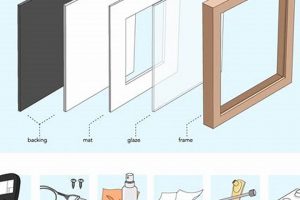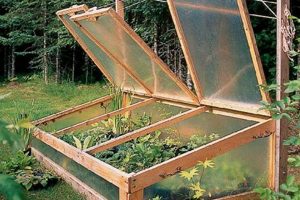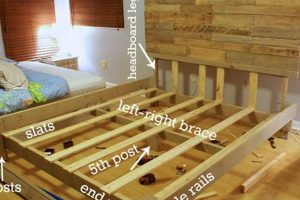A self-constructed support structure intended for suspending swings and other recreational attachments in a backyard or playground setting represents a cost-effective and customizable alternative to commercially manufactured swing sets. These structures are typically built using wood or metal and are designed to meet specific dimensional requirements and safety standards. As an example, a homeowner might choose to assemble a wooden A-frame to accommodate two swings and a trapeze bar.
Engaging in the creation of these recreational structures offers numerous advantages, including cost savings, tailored design, and the satisfaction of personal accomplishment. Historically, families have often built such structures to provide children with outdoor play opportunities. The appeal lies in the ability to adapt the dimensions, materials, and features to suit individual needs and available space. Such projects foster creativity and provide a unique and personal touch to backyard environments.
The following sections will delve into key considerations for planning, constructing, and maintaining such structures, including material selection, structural design principles, safety protocols, and common challenges encountered during the building process. Comprehensive guidance will be provided to facilitate the successful completion of a safe and durable structure.
Construction Tips for a Self-Assembled Swing Set Support
The successful construction of a durable and safe swing set support requires careful planning and execution. The following tips outline critical considerations for each stage of the process.
Tip 1: Precise Planning is Paramount: A detailed blueprint, incorporating accurate measurements and load calculations, is essential. Failure to adequately plan may result in structural instability or safety hazards. A structural engineers consultation may be beneficial.
Tip 2: Material Selection Affects Longevity: Opt for pressure-treated lumber or galvanized steel to resist weathering and decay. The specific choice depends on budget, desired aesthetics, and environmental conditions. Untreated materials will degrade rapidly.
Tip 3: Secure Fasteners Ensure Stability: Employ high-quality bolts, screws, and brackets designed for outdoor use. Under-rated or corroded fasteners can lead to structural failure. Stainless steel options offer superior corrosion resistance.
Tip 4: Proper Anchoring Mitigates Movement: Secure the base of the structure with concrete footings or ground anchors to prevent tipping or shifting. The depth and size of the footings should correspond to soil type and expected load. This is especially critical in windy areas.
Tip 5: Leveling is Critical for Stability: Ensure all posts and beams are perfectly level and plumb to distribute weight evenly. Uneven distribution increases stress on specific joints and can compromise the entire structure. Use a level and shims as needed.
Tip 6: Regular Inspection Prevents Accidents: Conduct routine inspections of all components for signs of wear, corrosion, or damage. Promptly replace any compromised parts to maintain structural integrity. Pay particular attention to joints and connections.
Tip 7: Adhere to Safety Standards: Ensure the design and construction align with established safety standards outlined by organizations such as the ASTM. This provides a baseline for safe construction practices.
Adhering to these construction tips will significantly contribute to the safety and longevity of the swing set support structure, ensuring years of enjoyment.
The following sections will explore specific design considerations for varying structural types.
1. Structural Integrity
Structural integrity, in the context of a self-constructed swing set support, is the capacity of the structure to withstand applied loads without failure. This capacity is paramount to ensuring user safety and preventing collapse. A compromised structure poses a significant risk of injury.
- Load-Bearing Capacity
This refers to the maximum weight the structure can safely support. It encompasses the weight of the swings, any attached accessories, and the combined weight of the users. Exceeding the designed load-bearing capacity can lead to deformation, cracking, or catastrophic failure. Load-bearing calculations must account for dynamic forces, such as the impact of swinging motions.
- Material Strength
The strength of the materials used directly influences the structure’s overall integrity. Different types of wood and metal possess varying degrees of tensile, compressive, and shear strength. Selection of appropriate materials requires consideration of these properties and the environmental conditions to which the structure will be exposed. Insufficient material strength will result in premature failure.
- Joint Stability
Joints, where structural members connect, are often the weakest points. Secure and properly engineered joints are essential for distributing loads effectively and preventing localized stress concentrations. The use of appropriate fasteners, such as bolts, screws, and brackets, is critical. Improperly constructed joints can cause instability and increase the risk of collapse.
- Stability Against Overturning
A structure must resist the forces that could cause it to tip or overturn. This is achieved through proper anchoring to the ground and a stable base design. Factors such as wind loading and the momentum of swinging users can exert significant overturning forces. Inadequate anchoring or a poorly designed base can lead to instability and potential accidents.
The interplay of these facets dictates the overall structural integrity of a self-built swing set support. Neglecting any single facet can compromise the entire structure and jeopardize user safety. A thorough understanding of these principles is fundamental to a successful and safe project.
2. Material Selection
In the context of self-assembled swing set supports, material selection exerts a direct influence on the structural integrity, longevity, and overall safety of the structure. The choice of materials dictates the capacity of the frame to withstand environmental stressors, resist decay, and support intended loads. For example, the selection of untreated lumber, while potentially cost-effective initially, leads to rapid degradation and structural weakening due to moisture, insect infestation, and fungal growth. This, in turn, precipitates a higher risk of collapse and potential injury to users. Conversely, employing pressure-treated lumber or galvanized steel provides enhanced resistance to weathering and decay, thereby extending the lifespan and improving the safety profile of the structure. The initial investment in appropriate materials translates to long-term cost savings by reducing the need for frequent repairs or replacements. The practical significance lies in minimizing potential hazards and ensuring a safe recreational environment.
Further analysis reveals the interdependency between material characteristics and structural design. The load-bearing capacity of a specific wood type, such as redwood versus pine, directly informs the dimensions required for structural members. Insufficient consideration of material strength necessitates over-engineering the design, potentially increasing material costs and construction complexity. Moreover, the choice of fasteners, such as galvanized or stainless steel, impacts the longevity and stability of joints. Inferior fasteners corrode over time, weakening connections and compromising the structural integrity of the frame. A comprehensive understanding of material properties and their interaction with design parameters is essential for optimizing both safety and cost-effectiveness.
In summary, material selection is a critical determinant of the success of a self-constructed swing set support. The challenges associated with this aspect involve balancing cost considerations with the need for durability and safety. Proper material selection contributes directly to structural integrity, long-term stability, and user safety. Addressing these challenges ensures the creation of a secure and enjoyable recreational structure.
3. Joint Strength
Joint strength is a critical consideration in the design and construction of a self-assembled swing set support structure. The integrity of the joints directly impacts the overall stability and safety of the framework. Inadequate joint strength can lead to premature failure, posing a significant hazard to users.
- Fastener Selection and Application
The selection and proper application of fasteners, such as bolts, screws, and lag screws, are fundamental to joint strength. The type and size of the fastener must be appropriate for the materials being joined and the anticipated loads. For instance, using undersized screws in a high-stress joint will result in premature failure. Furthermore, proper installation techniques, including pre-drilling and tightening to specified torque values, are essential for achieving optimal holding power. The absence of these considerations directly compromises the structural integrity of the joint and, consequently, the swing set support.
- Joint Design and Configuration
The geometric design of the joint significantly affects its strength and stability. For example, a mortise and tenon joint, properly executed, offers superior resistance to shear forces compared to a simple butt joint secured with screws. The configuration should be chosen to distribute stress evenly and minimize stress concentrations. A poorly designed joint will act as a weak point in the structure, regardless of the materials or fasteners used. Therefore, careful consideration of joint design is imperative for ensuring structural integrity.
- Material Compatibility
The compatibility of the materials being joined influences joint strength. For instance, when connecting dissimilar metals, galvanic corrosion can occur, weakening the joint over time. Similarly, the use of inappropriate adhesives or sealants between wood members can accelerate decay and reduce joint strength. Proper material selection and the use of compatible joining methods are critical for preventing premature degradation and maintaining long-term structural integrity.
- Environmental Considerations
Exposure to environmental elements, such as moisture and temperature fluctuations, can significantly impact joint strength. Wood joints are particularly susceptible to swelling and shrinking, which can loosen fasteners and compromise the integrity of the connection. Galvanized or stainless-steel fasteners are essential in outdoor applications to prevent corrosion and maintain holding power. Addressing environmental factors in the design and construction process is crucial for ensuring the long-term durability and safety of the swing set support structure.
The multifaceted nature of joint strength necessitates a comprehensive approach to design and construction. Attention to fastener selection, joint configuration, material compatibility, and environmental considerations are all crucial for creating a safe and durable swing set support. Neglecting these factors can lead to structural instability and potential harm to users.
4. Anchoring System
An anchoring system is a critical component in the construction of a self-assembled swing set support structure. It provides stability and prevents the structure from tipping or shifting during use, safeguarding against potential injuries. The selection and implementation of an appropriate anchoring system directly impact the overall safety and longevity of the recreational equipment.
- Concrete Footings
Concrete footings involve embedding the support posts of the swing set frame in concrete. This method provides substantial resistance against overturning forces. The dimensions of the footings (depth and width) must be determined based on soil conditions, the height of the swing set, and anticipated loads. Improperly sized footings offer inadequate resistance, particularly in loose or unstable soil, leading to a compromised anchoring system.
- Ground Anchors
Ground anchors are metal devices designed to be driven or screwed into the ground. They are then connected to the swing set frame using chains or straps. The effectiveness of ground anchors depends on the type of anchor, soil conditions, and proper installation. For example, helical anchors provide greater holding power in softer soils compared to simpler stake anchors. Incorrect installation or use of inappropriate anchor types can result in anchor failure and instability of the swing set.
- Surface Mounting with Weights
This approach involves attaching the swing set frame to a stable surface, such as a concrete patio or deck, using heavy weights or ballast. While suitable for temporary installations or when ground penetration is not feasible, this method generally provides less stability than concrete footings or ground anchors. The weight distribution and secure attachment of the weights are critical factors. Insufficient weight or inadequate attachment can result in the swing set shifting or tipping, particularly under heavy use.
- Combined Systems
A combination of anchoring methods may be employed to achieve optimal stability. For instance, concrete footings can be used in conjunction with ground anchors to provide enhanced resistance against overturning in challenging soil conditions or for particularly large swing set frames. The specific combination depends on site-specific factors and the design characteristics of the swing set. A well-integrated system maximizes stability and minimizes the risk of accidents.
The selection and proper installation of an anchoring system are essential for ensuring the safety and stability of any self-constructed swing set support. Each method possesses advantages and disadvantages, and the optimal choice depends on factors such as soil conditions, swing set design, and intended use. Prioritizing a robust anchoring system is a fundamental aspect of responsible swing set construction, contributing directly to a safe and enjoyable recreational environment.
5. Dimensional Accuracy
Dimensional accuracy, in the context of a self-constructed swing set support structure, refers to the precision with which the dimensions of the frame are measured, cut, and assembled according to the design specifications. This accuracy is paramount to ensuring structural integrity, load-bearing capacity, and overall safety. Deviations from specified dimensions can lead to uneven weight distribution, weakened joints, and an increased risk of collapse.
- Impact on Structural Stability
Accurate dimensions are essential for ensuring that all structural members bear the intended loads. For instance, if a support post is shorter than specified, it may not adequately support the crossbeam, leading to increased stress on adjacent joints. This uneven load distribution compromises the overall stability of the frame. Real-world examples include swing sets with noticeable leans or sags due to dimensional inaccuracies in post lengths. The implications are a reduced margin of safety and an increased likelihood of structural failure.
- Influence on Joint Integrity
Precise measurements are critical for creating secure and properly aligned joints. If the members being joined are not cut to the exact specified lengths and angles, the resulting joints will be weak and prone to failure. A common example is a miter joint that does not meet properly due to inaccurate cuts, resulting in gaps and reduced surface area for adhesive or fasteners. This diminished joint integrity can compromise the load-bearing capacity of the frame, increasing the risk of collapse under load.
- Effect on Weight Distribution
Dimensional inaccuracies directly impact the distribution of weight across the structure. When members are not of the specified lengths, the load is not distributed evenly, leading to localized stress concentrations. A practical example is a swing set where one swing bay is noticeably lower than the others due to variations in the length of the top beam supports. This uneven distribution of weight can cause premature wear and tear on specific components, shortening the lifespan of the structure and increasing the risk of failure.
- Consequences for Safety Compliance
Adherence to specified dimensions is often a requirement for compliance with safety standards and building codes. These standards prescribe minimum dimensions for structural members and maximum allowable deviations. Failure to meet these dimensional requirements can result in a non-compliant structure, posing a safety hazard. An example would be a swing set with insufficient clearance between the swings and the support structure due to inaccurate dimensions, increasing the risk of impact injuries.
In conclusion, dimensional accuracy is a non-negotiable aspect of constructing a safe and durable self-assembled swing set support structure. Its influence extends across all aspects of structural integrity, joint integrity, weight distribution, and safety compliance. Thorough planning, precise measurements, and careful construction techniques are essential for achieving dimensional accuracy and ensuring the long-term safety and stability of the recreational structure.
6. Safety Compliance
Safety compliance represents a critical facet of self-constructed swing set supports. Adherence to established safety standards minimizes the risk of injuries and ensures the creation of a safe recreational environment. Failure to comply with relevant guidelines can result in severe consequences, including structural failure and user harm. Prioritizing safety compliance during the design, construction, and maintenance phases is therefore paramount.
- Adherence to ASTM Standards
The American Society for Testing and Materials (ASTM) publishes comprehensive standards for playground equipment, including swing sets. Compliance with these standards, such as ASTM F1148 (Standard Consumer Safety Performance Specification for Home Playground Equipment), mandates specific dimensional requirements, material specifications, and testing protocols. For example, adherence to ASTM F1148 requires impact-attenuating surfacing beneath and around the swing set to mitigate fall-related injuries. Non-compliance with ASTM standards exposes users to heightened risks and potentially legal liabilities.
- Building Code Regulations
Local building codes may impose additional requirements for structures erected on residential properties. These regulations can encompass zoning restrictions, setback requirements, and safety-related provisions. Compliance with building codes ensures that the swing set support structure meets minimum safety and structural integrity standards specific to the local environment. Disregarding building codes can lead to fines, mandated removal of the structure, and potential legal ramifications in the event of an accident.
- Material Safety and Toxicity
Safety compliance extends to the selection of materials used in construction. Pressure-treated lumber, while offering resistance to decay, may contain chemicals that pose health risks if not handled properly. The use of lead-based paints or coatings is strictly prohibited due to their toxicity. Compliance with material safety regulations, such as those outlined by the Environmental Protection Agency (EPA), ensures that the swing set structure does not pose a chemical hazard to users or the environment. Failure to adhere to these regulations can result in environmental contamination and health-related complications.
- Regular Inspection and Maintenance Protocols
Safety compliance is not a one-time event but an ongoing process. Regular inspections are essential for identifying signs of wear, damage, or deterioration. Maintenance protocols, such as tightening loose fasteners, replacing damaged components, and reapplying protective coatings, are crucial for preserving the structural integrity and safety of the swing set support. Failure to conduct regular inspections and maintenance increases the risk of component failure and accidents, potentially leading to serious injuries.
The aforementioned facets illustrate the multifaceted nature of safety compliance in the context of self-constructed swing set supports. Comprehensive adherence to ASTM standards, building codes, material safety regulations, and regular inspection protocols contributes significantly to minimizing risks and ensuring a safe recreational experience. The long-term benefits of prioritizing safety compliance outweigh the initial investment in time and resources.
7. Weather Resistance
Weather resistance is a critical performance parameter for self-constructed swing set support structures. Exposure to environmental elements such as precipitation, solar radiation, and temperature fluctuations directly impacts the longevity, structural integrity, and safety of these recreational frameworks.
- Material Degradation
Prolonged exposure to weather accelerates the degradation of materials commonly used in these structures. Untreated wood is susceptible to rot, decay, and insect infestation, leading to structural weakening. Metals, without proper protective coatings, can corrode, compromising joint strength and load-bearing capacity. For example, a wooden frame exposed to consistent moisture may exhibit significant decay within a few years, necessitating costly repairs or replacement. The implications are a reduced lifespan and increased safety risks.
- UV Radiation Effects
Ultraviolet (UV) radiation from sunlight degrades many materials, including plastics and certain types of wood finishes. This degradation can result in discoloration, cracking, and a reduction in material strength. For example, plastic swing seats exposed to intense sunlight can become brittle and prone to breaking. The consequences include potential injuries and the need for frequent component replacements.
- Expansion and Contraction
Temperature fluctuations cause materials to expand and contract. This cyclical expansion and contraction can weaken joints and connections over time. For instance, wooden members may swell in humid conditions and shrink during dry periods, loosening fasteners and creating instability. The repeated stress can lead to structural fatigue and an increased risk of failure.
- Protective Coatings and Treatments
The application of weather-resistant coatings and treatments is essential for mitigating the effects of environmental exposure. Pressure-treated lumber resists rot and decay. Galvanized or powder-coated metal components resist corrosion. UV-resistant coatings protect against sun damage. These treatments extend the lifespan of the structure and enhance its safety. The absence of such protective measures significantly reduces the durability and reliability of the swing set support.
The preceding facets underscore the critical importance of weather resistance in the context of self-built swing set frameworks. Employing appropriate materials, applying protective treatments, and designing for environmental conditions are essential for ensuring a safe and durable recreational structure. Neglecting these considerations compromises the long-term performance and safety of the swing set support, potentially leading to hazardous situations.
Frequently Asked Questions
The following addresses common inquiries regarding the construction, safety, and maintenance of self-assembled swing set supports.
Question 1: What are the essential materials for constructing a durable swing set support?
Pressure-treated lumber or galvanized steel are the preferred materials due to their resistance to weathering and decay. Fasteners should be corrosion-resistant, such as galvanized or stainless steel, to ensure long-term joint integrity.
Question 2: How should the structure be anchored to ensure stability?
Concrete footings provide a stable foundation in most soil conditions. Alternatively, ground anchors, properly installed, offer adequate resistance to overturning. The choice depends on soil type and anticipated loads.
Question 3: What safety standards should be considered during construction?
Compliance with ASTM F1148, the Standard Consumer Safety Performance Specification for Home Playground Equipment, is highly recommended. Local building codes should also be consulted for additional requirements.
Question 4: How can the structural integrity of the joints be ensured?
Joints should be designed to distribute stress evenly and minimize stress concentrations. Proper fastener selection and installation, along with the use of appropriate adhesives, are critical for maintaining joint strength.
Question 5: How often should the swing set support be inspected and maintained?
Routine inspections should be conducted at least twice annually, preferably at the beginning and end of the primary usage season. Maintenance protocols should include tightening loose fasteners, replacing damaged components, and reapplying protective coatings.
Question 6: What are the potential risks of failing to comply with safety standards?
Failure to comply with safety standards can result in structural instability, component failure, and an increased risk of injuries to users. Moreover, non-compliance may lead to legal liabilities in the event of an accident.
These FAQs offer a foundational understanding of key considerations for safe and durable self-assembled swing set supports. Adherence to these principles will significantly enhance the recreational experience.
The subsequent section will explore advanced design considerations for specialized applications.
Concluding Remarks on Self-Assembled Swing Set Supports
The preceding discussion explored the complexities associated with the construction of a safe and durable diy swing set frame. Crucial aspects such as material selection, joint strength, anchoring systems, dimensional accuracy, safety compliance, and weather resistance were examined. Emphasizing these elements will significantly enhance the recreational structure’s performance and longevity.
The responsible construction of a diy swing set frame demands meticulous planning, adherence to safety standards, and a commitment to ongoing maintenance. Prioritizing these factors is essential for ensuring a secure and enjoyable environment for all users. Failure to do so presents unacceptable risks.







